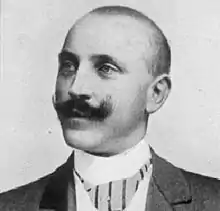Henri Rinck
Henri Rinck (January 10, 1870 – February 17, 1952) was a French chess study composer, considered one of the most important early figures in the field.

Biography
Henri Rinck was born in Lyon (France) on January 10, 1870, where his family were brewers (Brasserie Rinck). He graduated as a chemical engineer at the Technische Hochschule of Munich (Germany). He then worked at the Faculté des Sciences in Lyon as an assistant of Dr. Barbier.
In 1897 he discovered a refining process for green vegetable oils, which was applied in Marseille (France), then by several olive oil refineries in Spain. In 1900 he set up a factory in Badalona (Spain) and lived there with his family. Before the end of the Spanish civil war he had to leave Spain. He established himself in Marseille, but returned to Spain later.
His first chess endgame studies appeared from 1902 in the "Deutsche Schachzeitung". In 1909 he published the first collection "150 fins de partie" (with an introduction by Johann Berger). A second edition followed in 1913, a third edition in 1919 ("300 fins de partie") and a fourth edition in 1927 ("700 fins de partie"). In 1947 he published "Las sorpresas de la teoría" (The Surprises of Theory), containing 111 endgames on two rooks against two minor pieces, and, together with Louis Malpas, "Dame contre tour et cavalier" (Queen against Rook and Knight). Rinck was one of the most prolific composers, having published as many as 1670 endgame studies, 58 of which won first prize in tourneys of study composition.
Rinck died in Badalona on February 17, 1952.[1] Six days before his death he was handed out the first copy of his ultimate collection "1414 fins de partie". On his request he was buried with this book under his arm.
Composition
The diagram below shows one of Rincks' controversial studies.
1414 fins de partie, nr. 126
| a | b | c | d | e | f | g | h | ||
| 8 |  | 8 | |||||||
| 7 | 7 | ||||||||
| 6 | 6 | ||||||||
| 5 | 5 | ||||||||
| 4 | 4 | ||||||||
| 3 | 3 | ||||||||
| 2 | 2 | ||||||||
| 1 | 1 | ||||||||
| a | b | c | d | e | f | g | h | ||
Solution:
1. Qe4+ Ka6 2. Rh6+ Rf6 3. Qf5! wins
- 1. ... Kb8 2. Rh8+ Kc7 3. Rh7 Rf2+ 4. Kc3 Rf3+ 5. Kd4(b4) wins
- 1. ... Kb6 2. Rh6+ Kc5(a5,b5) 3. Qe5+ Qd5 4. Qc7+ wins
André Chéron, in "Lehr- und Handbuch der Endspiele", considered the study incorrect:
Black would draw with 1. Qe4+ Ka6 2. Rh6+ Rf6 3. Qf5 Rxh6 4. Qxf7 Rc6!=
Computer analysis however has proved the correctness of the study:
after 4...Rc6 White delivers mate in 34 moves.
Notes
- "Most sources indicate that Henri Rinck died on February 18 or 26, 1952. Wrong! Monsieur Didier Rinck showed us his death certificate: 17 février 1952. Purists should correct this." - Lyon Olympique Echecs
References
- Rinck, Henri (1909), 150 fins de partie, Leipzig (Veit)
- Rinck, Henri (1913), 150 fins de partie (2e édition), Leipzig
- Rinck, Henri (1919), 300 fins de partie (3e édition de "150 fins de partie"), Barcelona (Hijos de Paluzie)
- Rinck, Henri (1927), 700 fins de partie (4e édition de "150 fins de partie"), Barcelona (Tip. La AcadEmica)
- Rinck, Henri (1950), 1414 fins de partie (5e édition de "150 fins de partie"), Barcelona (Tip. La AcadEmica) (dated 1950, published 1952, according to The Oxford Companion to Chess)
- Rinck, Henri (1982), 1414 fins de partie (Reprint), Zürich (Olms), ISBN 3-283-00093-X
- Rinck, Henri (1950), Las sorpresas de la teoría – Les Surprises de la théorie. 111 finales, Madrid (Ed. Dossat)
- Chéron, André (1958), Lehr- und Handbuch der Endspiele (Band III), Berlin-Frohnau (Siegfried Engelhardt Verlag)
Further reading
- Endgame Lab: Henry Rinck (1870-1952), by Pal Benko, Chess Life, August 2010, pp. 44–45.
External links
- A Magnificent Royal Tango: study 932 from "1414 fins de partie", explained by Александра Костенюк
- Extrait de l’Historique des échecs à Lyon. La période 1892-1952: Henri RINCK (in French)
- Portrait of Henri Rinck (in French)